Detailed Report on Site Investigation, Foundation, and Roof Design
VerifiedAdded on 2023/01/04
|10
|2703
|21
Report
AI Summary
This report provides a detailed overview of site investigation, encompassing reconnaissance, data analysis, and in-depth investigation techniques. It explores foundation design, including depth considerations, drainage, and excavation methods, along with the selection of key components such as foundations, plinths, DPC, plinth beams, floors, and walls. The report also delves into first floors and roof designs, comparing timber joists and I-joists, and presenting various flat roof options like cold roofs, warm roofs, and inverted roofs, along with considerations for falls and drainage. Finally, it discusses options for pitched roofs for new houses, offering a comprehensive understanding of structural design and construction practices in civil engineering.

1 REPORT
Paraphrase This Document
Need a fresh take? Get an instant paraphrase of this document with our AI Paraphraser
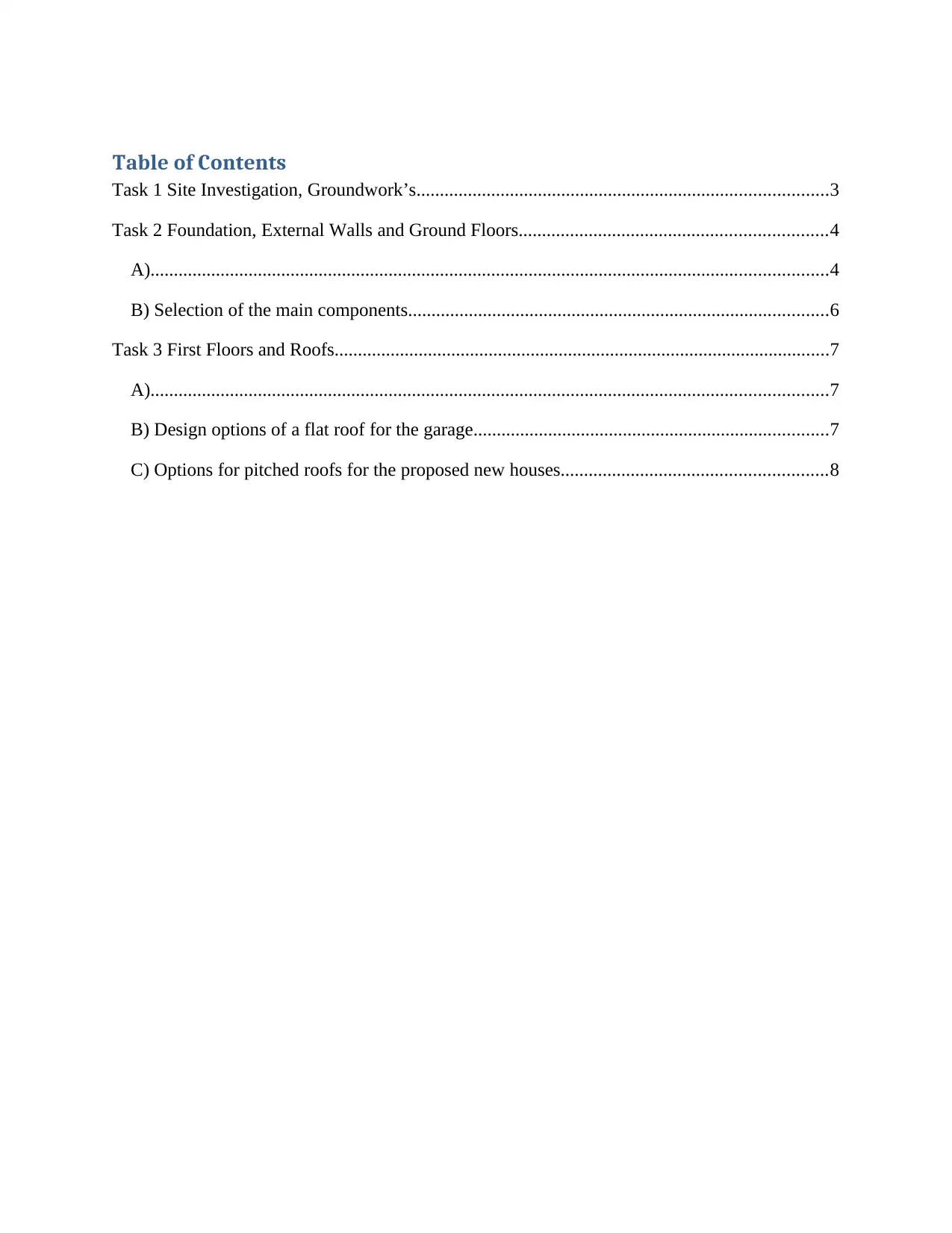
Table of Contents
Task 1 Site Investigation, Groundwork’s........................................................................................3
Task 2 Foundation, External Walls and Ground Floors..................................................................4
A).................................................................................................................................................4
B) Selection of the main components..........................................................................................6
Task 3 First Floors and Roofs..........................................................................................................7
A).................................................................................................................................................7
B) Design options of a flat roof for the garage............................................................................7
C) Options for pitched roofs for the proposed new houses.........................................................8
Task 1 Site Investigation, Groundwork’s........................................................................................3
Task 2 Foundation, External Walls and Ground Floors..................................................................4
A).................................................................................................................................................4
B) Selection of the main components..........................................................................................6
Task 3 First Floors and Roofs..........................................................................................................7
A).................................................................................................................................................7
B) Design options of a flat roof for the garage............................................................................7
C) Options for pitched roofs for the proposed new houses.........................................................8
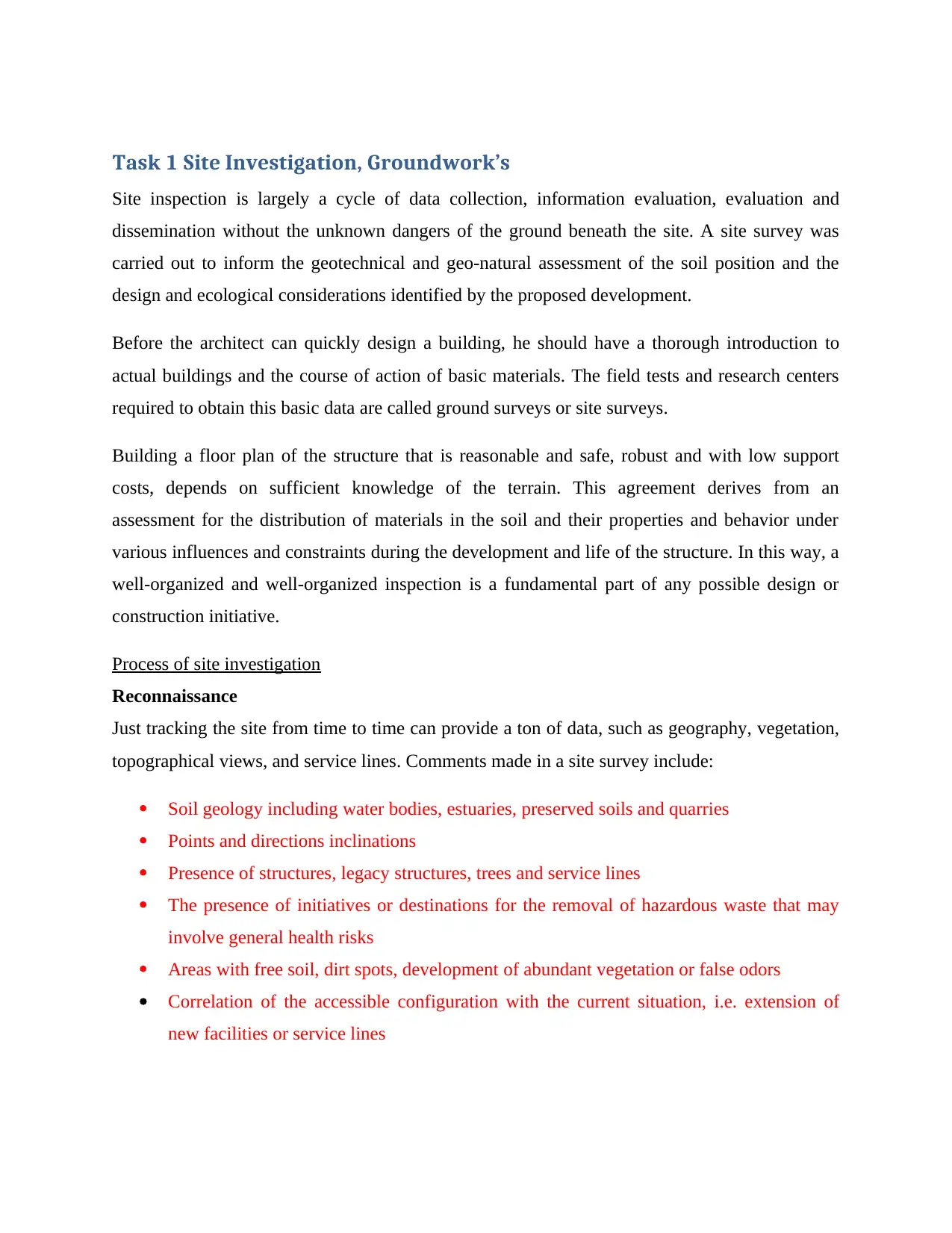
Task 1 Site Investigation, Groundwork’s
Site inspection is largely a cycle of data collection, information evaluation, evaluation and
dissemination without the unknown dangers of the ground beneath the site. A site survey was
carried out to inform the geotechnical and geo-natural assessment of the soil position and the
design and ecological considerations identified by the proposed development.
Before the architect can quickly design a building, he should have a thorough introduction to
actual buildings and the course of action of basic materials. The field tests and research centers
required to obtain this basic data are called ground surveys or site surveys.
Building a floor plan of the structure that is reasonable and safe, robust and with low support
costs, depends on sufficient knowledge of the terrain. This agreement derives from an
assessment for the distribution of materials in the soil and their properties and behavior under
various influences and constraints during the development and life of the structure. In this way, a
well-organized and well-organized inspection is a fundamental part of any possible design or
construction initiative.
Process of site investigation
Reconnaissance
Just tracking the site from time to time can provide a ton of data, such as geography, vegetation,
topographical views, and service lines. Comments made in a site survey include:
Soil geology including water bodies, estuaries, preserved soils and quarries
Points and directions inclinations
Presence of structures, legacy structures, trees and service lines
The presence of initiatives or destinations for the removal of hazardous waste that may
involve general health risks
Areas with free soil, dirt spots, development of abundant vegetation or false odors
Correlation of the accessible configuration with the current situation, i.e. extension of
new facilities or service lines
Site inspection is largely a cycle of data collection, information evaluation, evaluation and
dissemination without the unknown dangers of the ground beneath the site. A site survey was
carried out to inform the geotechnical and geo-natural assessment of the soil position and the
design and ecological considerations identified by the proposed development.
Before the architect can quickly design a building, he should have a thorough introduction to
actual buildings and the course of action of basic materials. The field tests and research centers
required to obtain this basic data are called ground surveys or site surveys.
Building a floor plan of the structure that is reasonable and safe, robust and with low support
costs, depends on sufficient knowledge of the terrain. This agreement derives from an
assessment for the distribution of materials in the soil and their properties and behavior under
various influences and constraints during the development and life of the structure. In this way, a
well-organized and well-organized inspection is a fundamental part of any possible design or
construction initiative.
Process of site investigation
Reconnaissance
Just tracking the site from time to time can provide a ton of data, such as geography, vegetation,
topographical views, and service lines. Comments made in a site survey include:
Soil geology including water bodies, estuaries, preserved soils and quarries
Points and directions inclinations
Presence of structures, legacy structures, trees and service lines
The presence of initiatives or destinations for the removal of hazardous waste that may
involve general health risks
Areas with free soil, dirt spots, development of abundant vegetation or false odors
Correlation of the accessible configuration with the current situation, i.e. extension of
new facilities or service lines
⊘ This is a preview!⊘
Do you want full access?
Subscribe today to unlock all pages.

Trusted by 1+ million students worldwide
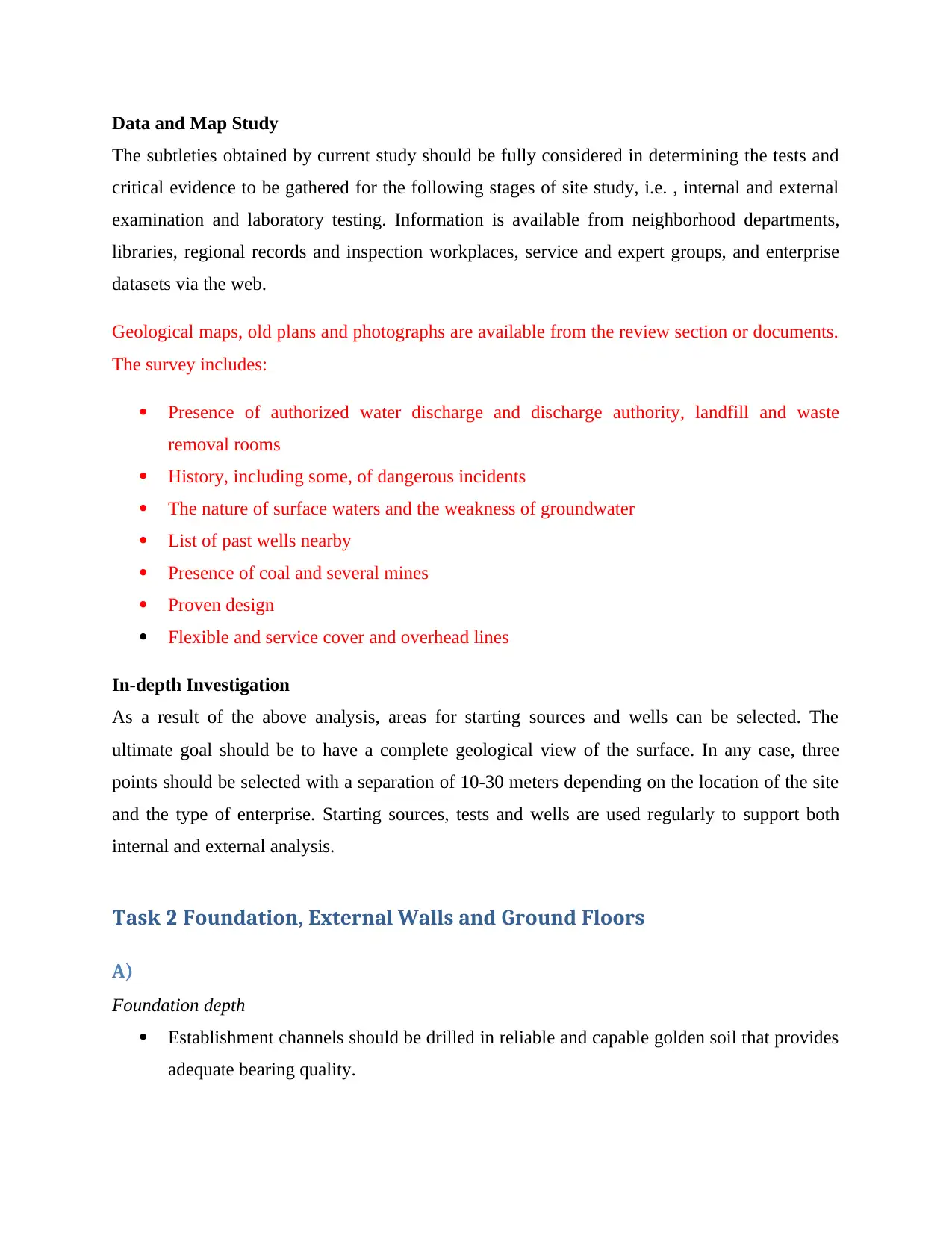
Data and Map Study
The subtleties obtained by current study should be fully considered in determining the tests and
critical evidence to be gathered for the following stages of site study, i.e. , internal and external
examination and laboratory testing. Information is available from neighborhood departments,
libraries, regional records and inspection workplaces, service and expert groups, and enterprise
datasets via the web.
Geological maps, old plans and photographs are available from the review section or documents.
The survey includes:
Presence of authorized water discharge and discharge authority, landfill and waste
removal rooms
History, including some, of dangerous incidents
The nature of surface waters and the weakness of groundwater
List of past wells nearby
Presence of coal and several mines
Proven design
Flexible and service cover and overhead lines
In-depth Investigation
As a result of the above analysis, areas for starting sources and wells can be selected. The
ultimate goal should be to have a complete geological view of the surface. In any case, three
points should be selected with a separation of 10-30 meters depending on the location of the site
and the type of enterprise. Starting sources, tests and wells are used regularly to support both
internal and external analysis.
Task 2 Foundation, External Walls and Ground Floors
A)
Foundation depth
Establishment channels should be drilled in reliable and capable golden soil that provides
adequate bearing quality.
The subtleties obtained by current study should be fully considered in determining the tests and
critical evidence to be gathered for the following stages of site study, i.e. , internal and external
examination and laboratory testing. Information is available from neighborhood departments,
libraries, regional records and inspection workplaces, service and expert groups, and enterprise
datasets via the web.
Geological maps, old plans and photographs are available from the review section or documents.
The survey includes:
Presence of authorized water discharge and discharge authority, landfill and waste
removal rooms
History, including some, of dangerous incidents
The nature of surface waters and the weakness of groundwater
List of past wells nearby
Presence of coal and several mines
Proven design
Flexible and service cover and overhead lines
In-depth Investigation
As a result of the above analysis, areas for starting sources and wells can be selected. The
ultimate goal should be to have a complete geological view of the surface. In any case, three
points should be selected with a separation of 10-30 meters depending on the location of the site
and the type of enterprise. Starting sources, tests and wells are used regularly to support both
internal and external analysis.
Task 2 Foundation, External Walls and Ground Floors
A)
Foundation depth
Establishment channels should be drilled in reliable and capable golden soil that provides
adequate bearing quality.
Paraphrase This Document
Need a fresh take? Get an instant paraphrase of this document with our AI Paraphraser
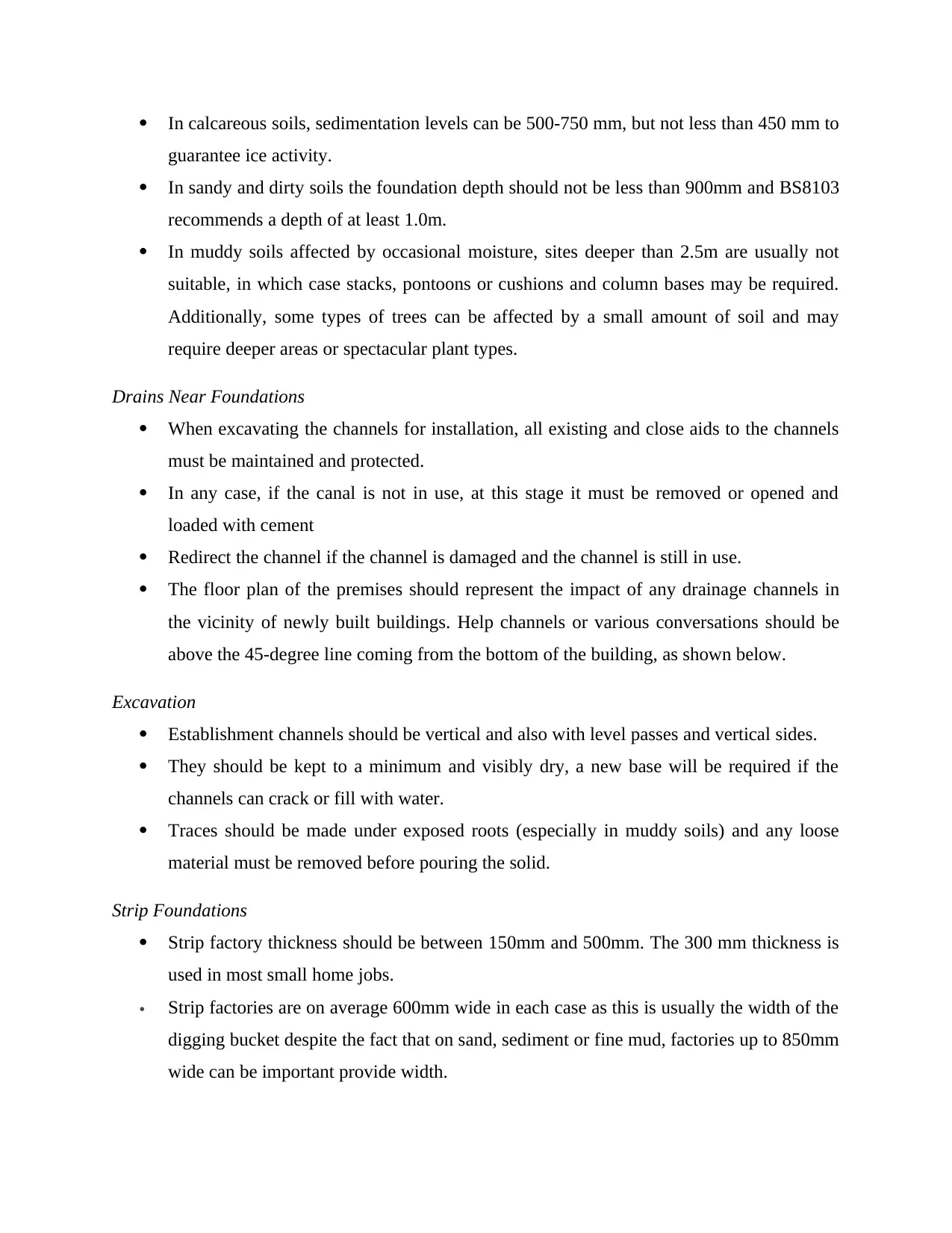
In calcareous soils, sedimentation levels can be 500-750 mm, but not less than 450 mm to
guarantee ice activity.
In sandy and dirty soils the foundation depth should not be less than 900mm and BS8103
recommends a depth of at least 1.0m.
In muddy soils affected by occasional moisture, sites deeper than 2.5m are usually not
suitable, in which case stacks, pontoons or cushions and column bases may be required.
Additionally, some types of trees can be affected by a small amount of soil and may
require deeper areas or spectacular plant types.
Drains Near Foundations
When excavating the channels for installation, all existing and close aids to the channels
must be maintained and protected.
In any case, if the canal is not in use, at this stage it must be removed or opened and
loaded with cement
Redirect the channel if the channel is damaged and the channel is still in use.
The floor plan of the premises should represent the impact of any drainage channels in
the vicinity of newly built buildings. Help channels or various conversations should be
above the 45-degree line coming from the bottom of the building, as shown below.
Excavation
Establishment channels should be vertical and also with level passes and vertical sides.
They should be kept to a minimum and visibly dry, a new base will be required if the
channels can crack or fill with water.
Traces should be made under exposed roots (especially in muddy soils) and any loose
material must be removed before pouring the solid.
Strip Foundations
Strip factory thickness should be between 150mm and 500mm. The 300 mm thickness is
used in most small home jobs.
Strip factories are on average 600mm wide in each case as this is usually the width of the
digging bucket despite the fact that on sand, sediment or fine mud, factories up to 850mm
wide can be important provide width.
guarantee ice activity.
In sandy and dirty soils the foundation depth should not be less than 900mm and BS8103
recommends a depth of at least 1.0m.
In muddy soils affected by occasional moisture, sites deeper than 2.5m are usually not
suitable, in which case stacks, pontoons or cushions and column bases may be required.
Additionally, some types of trees can be affected by a small amount of soil and may
require deeper areas or spectacular plant types.
Drains Near Foundations
When excavating the channels for installation, all existing and close aids to the channels
must be maintained and protected.
In any case, if the canal is not in use, at this stage it must be removed or opened and
loaded with cement
Redirect the channel if the channel is damaged and the channel is still in use.
The floor plan of the premises should represent the impact of any drainage channels in
the vicinity of newly built buildings. Help channels or various conversations should be
above the 45-degree line coming from the bottom of the building, as shown below.
Excavation
Establishment channels should be vertical and also with level passes and vertical sides.
They should be kept to a minimum and visibly dry, a new base will be required if the
channels can crack or fill with water.
Traces should be made under exposed roots (especially in muddy soils) and any loose
material must be removed before pouring the solid.
Strip Foundations
Strip factory thickness should be between 150mm and 500mm. The 300 mm thickness is
used in most small home jobs.
Strip factories are on average 600mm wide in each case as this is usually the width of the
digging bucket despite the fact that on sand, sediment or fine mud, factories up to 850mm
wide can be important provide width.
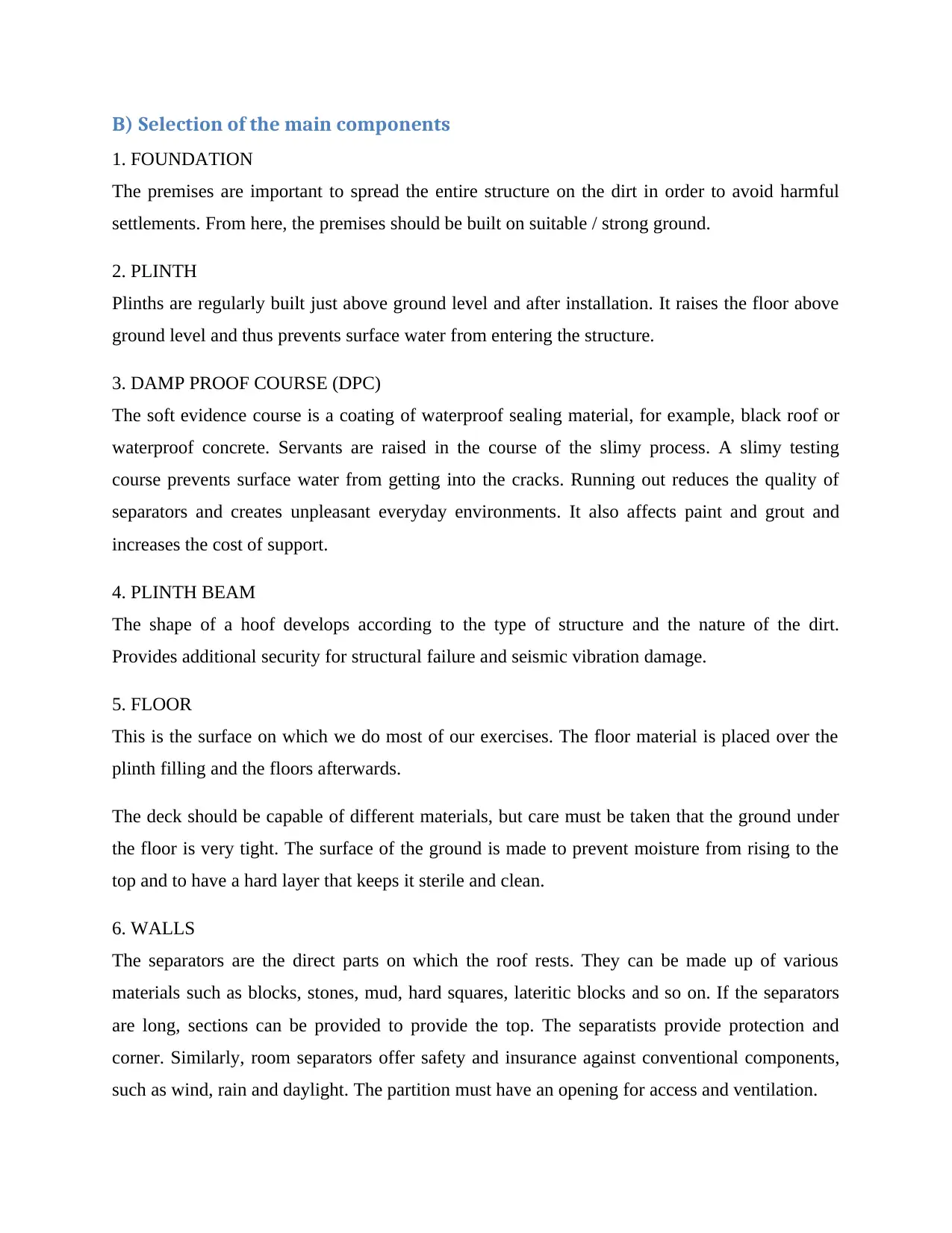
B) Selection of the main components
1. FOUNDATION
The premises are important to spread the entire structure on the dirt in order to avoid harmful
settlements. From here, the premises should be built on suitable / strong ground.
2. PLINTH
Plinths are regularly built just above ground level and after installation. It raises the floor above
ground level and thus prevents surface water from entering the structure.
3. DAMP PROOF COURSE (DPC)
The soft evidence course is a coating of waterproof sealing material, for example, black roof or
waterproof concrete. Servants are raised in the course of the slimy process. A slimy testing
course prevents surface water from getting into the cracks. Running out reduces the quality of
separators and creates unpleasant everyday environments. It also affects paint and grout and
increases the cost of support.
4. PLINTH BEAM
The shape of a hoof develops according to the type of structure and the nature of the dirt.
Provides additional security for structural failure and seismic vibration damage.
5. FLOOR
This is the surface on which we do most of our exercises. The floor material is placed over the
plinth filling and the floors afterwards.
The deck should be capable of different materials, but care must be taken that the ground under
the floor is very tight. The surface of the ground is made to prevent moisture from rising to the
top and to have a hard layer that keeps it sterile and clean.
6. WALLS
The separators are the direct parts on which the roof rests. They can be made up of various
materials such as blocks, stones, mud, hard squares, lateritic blocks and so on. If the separators
are long, sections can be provided to provide the top. The separatists provide protection and
corner. Similarly, room separators offer safety and insurance against conventional components,
such as wind, rain and daylight. The partition must have an opening for access and ventilation.
1. FOUNDATION
The premises are important to spread the entire structure on the dirt in order to avoid harmful
settlements. From here, the premises should be built on suitable / strong ground.
2. PLINTH
Plinths are regularly built just above ground level and after installation. It raises the floor above
ground level and thus prevents surface water from entering the structure.
3. DAMP PROOF COURSE (DPC)
The soft evidence course is a coating of waterproof sealing material, for example, black roof or
waterproof concrete. Servants are raised in the course of the slimy process. A slimy testing
course prevents surface water from getting into the cracks. Running out reduces the quality of
separators and creates unpleasant everyday environments. It also affects paint and grout and
increases the cost of support.
4. PLINTH BEAM
The shape of a hoof develops according to the type of structure and the nature of the dirt.
Provides additional security for structural failure and seismic vibration damage.
5. FLOOR
This is the surface on which we do most of our exercises. The floor material is placed over the
plinth filling and the floors afterwards.
The deck should be capable of different materials, but care must be taken that the ground under
the floor is very tight. The surface of the ground is made to prevent moisture from rising to the
top and to have a hard layer that keeps it sterile and clean.
6. WALLS
The separators are the direct parts on which the roof rests. They can be made up of various
materials such as blocks, stones, mud, hard squares, lateritic blocks and so on. If the separators
are long, sections can be provided to provide the top. The separatists provide protection and
corner. Similarly, room separators offer safety and insurance against conventional components,
such as wind, rain and daylight. The partition must have an opening for access and ventilation.
⊘ This is a preview!⊘
Do you want full access?
Subscribe today to unlock all pages.

Trusted by 1+ million students worldwide
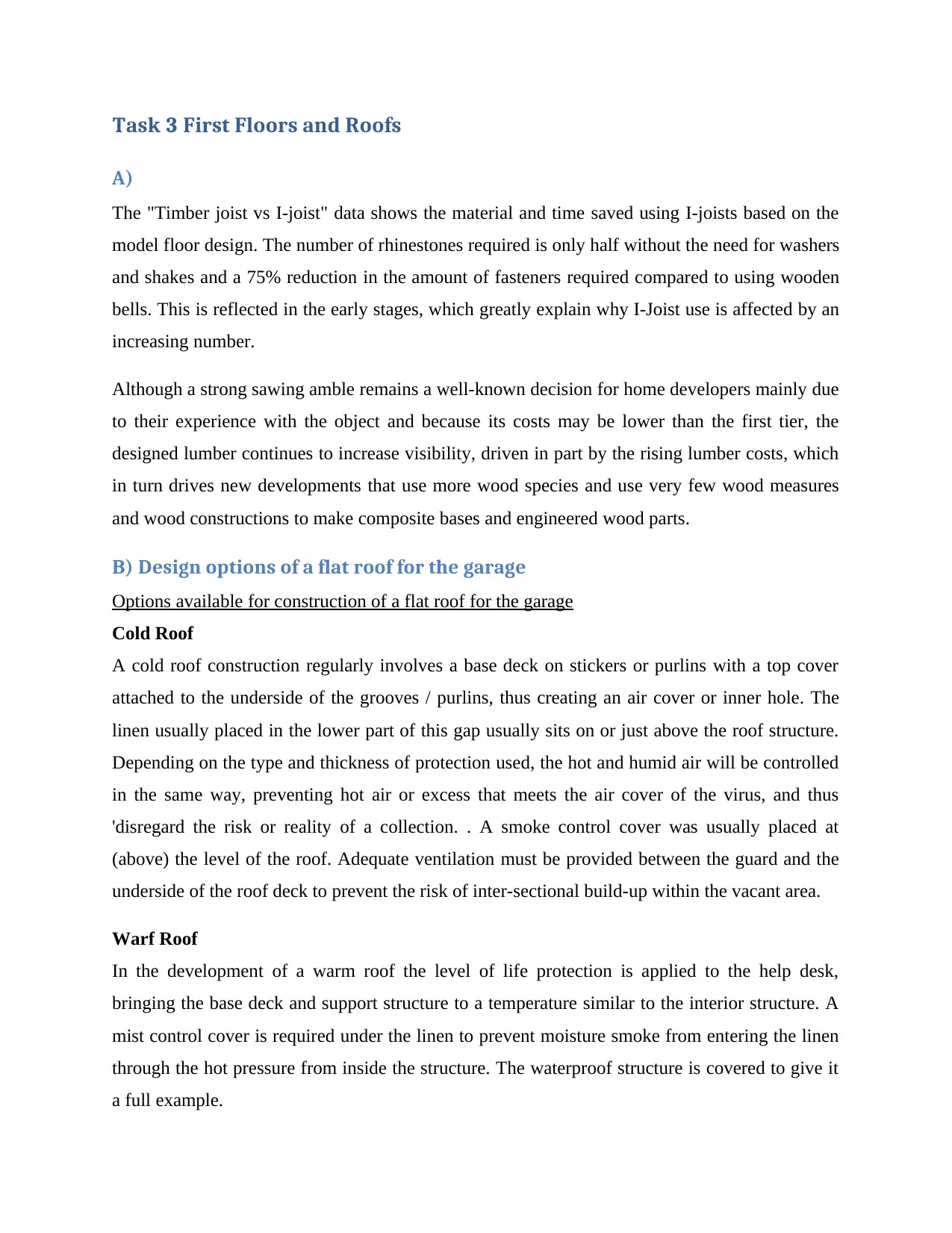
Task 3 First Floors and Roofs
A)
The "Timber joist vs I-joist" data shows the material and time saved using I-joists based on the
model floor design. The number of rhinestones required is only half without the need for washers
and shakes and a 75% reduction in the amount of fasteners required compared to using wooden
bells. This is reflected in the early stages, which greatly explain why I-Joist use is affected by an
increasing number.
Although a strong sawing amble remains a well-known decision for home developers mainly due
to their experience with the object and because its costs may be lower than the first tier, the
designed lumber continues to increase visibility, driven in part by the rising lumber costs, which
in turn drives new developments that use more wood species and use very few wood measures
and wood constructions to make composite bases and engineered wood parts.
B) Design options of a flat roof for the garage
Options available for construction of a flat roof for the garage
Cold Roof
A cold roof construction regularly involves a base deck on stickers or purlins with a top cover
attached to the underside of the grooves / purlins, thus creating an air cover or inner hole. The
linen usually placed in the lower part of this gap usually sits on or just above the roof structure.
Depending on the type and thickness of protection used, the hot and humid air will be controlled
in the same way, preventing hot air or excess that meets the air cover of the virus, and thus
'disregard the risk or reality of a collection. . A smoke control cover was usually placed at
(above) the level of the roof. Adequate ventilation must be provided between the guard and the
underside of the roof deck to prevent the risk of inter-sectional build-up within the vacant area.
Warf Roof
In the development of a warm roof the level of life protection is applied to the help desk,
bringing the base deck and support structure to a temperature similar to the interior structure. A
mist control cover is required under the linen to prevent moisture smoke from entering the linen
through the hot pressure from inside the structure. The waterproof structure is covered to give it
a full example.
A)
The "Timber joist vs I-joist" data shows the material and time saved using I-joists based on the
model floor design. The number of rhinestones required is only half without the need for washers
and shakes and a 75% reduction in the amount of fasteners required compared to using wooden
bells. This is reflected in the early stages, which greatly explain why I-Joist use is affected by an
increasing number.
Although a strong sawing amble remains a well-known decision for home developers mainly due
to their experience with the object and because its costs may be lower than the first tier, the
designed lumber continues to increase visibility, driven in part by the rising lumber costs, which
in turn drives new developments that use more wood species and use very few wood measures
and wood constructions to make composite bases and engineered wood parts.
B) Design options of a flat roof for the garage
Options available for construction of a flat roof for the garage
Cold Roof
A cold roof construction regularly involves a base deck on stickers or purlins with a top cover
attached to the underside of the grooves / purlins, thus creating an air cover or inner hole. The
linen usually placed in the lower part of this gap usually sits on or just above the roof structure.
Depending on the type and thickness of protection used, the hot and humid air will be controlled
in the same way, preventing hot air or excess that meets the air cover of the virus, and thus
'disregard the risk or reality of a collection. . A smoke control cover was usually placed at
(above) the level of the roof. Adequate ventilation must be provided between the guard and the
underside of the roof deck to prevent the risk of inter-sectional build-up within the vacant area.
Warf Roof
In the development of a warm roof the level of life protection is applied to the help desk,
bringing the base deck and support structure to a temperature similar to the interior structure. A
mist control cover is required under the linen to prevent moisture smoke from entering the linen
through the hot pressure from inside the structure. The waterproof structure is covered to give it
a full example.
Paraphrase This Document
Need a fresh take? Get an instant paraphrase of this document with our AI Paraphraser
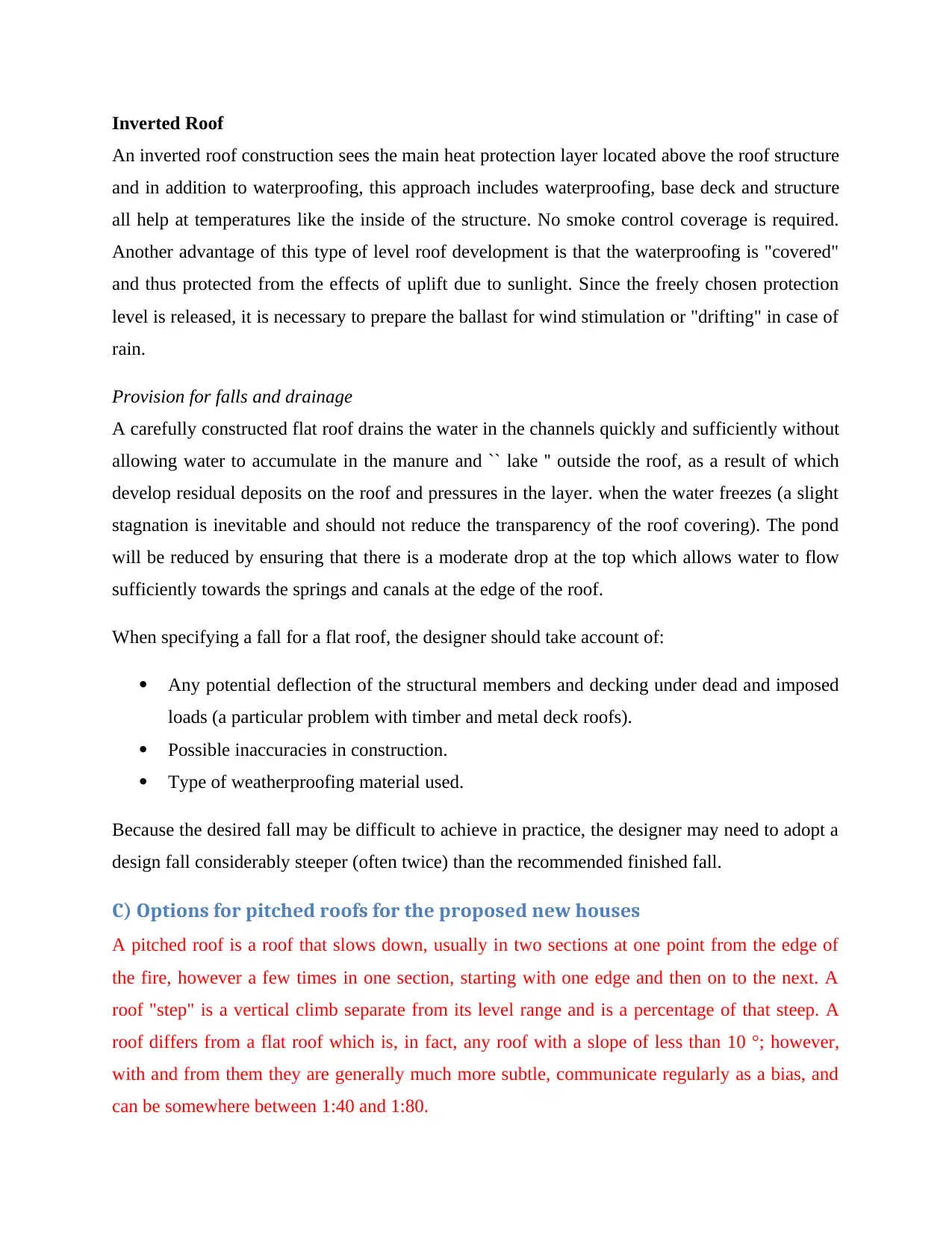
Inverted Roof
An inverted roof construction sees the main heat protection layer located above the roof structure
and in addition to waterproofing, this approach includes waterproofing, base deck and structure
all help at temperatures like the inside of the structure. No smoke control coverage is required.
Another advantage of this type of level roof development is that the waterproofing is "covered"
and thus protected from the effects of uplift due to sunlight. Since the freely chosen protection
level is released, it is necessary to prepare the ballast for wind stimulation or "drifting" in case of
rain.
Provision for falls and drainage
A carefully constructed flat roof drains the water in the channels quickly and sufficiently without
allowing water to accumulate in the manure and `` lake '' outside the roof, as a result of which
develop residual deposits on the roof and pressures in the layer. when the water freezes (a slight
stagnation is inevitable and should not reduce the transparency of the roof covering). The pond
will be reduced by ensuring that there is a moderate drop at the top which allows water to flow
sufficiently towards the springs and canals at the edge of the roof.
When specifying a fall for a flat roof, the designer should take account of:
Any potential deflection of the structural members and decking under dead and imposed
loads (a particular problem with timber and metal deck roofs).
Possible inaccuracies in construction.
Type of weatherproofing material used.
Because the desired fall may be difficult to achieve in practice, the designer may need to adopt a
design fall considerably steeper (often twice) than the recommended finished fall.
C) Options for pitched roofs for the proposed new houses
A pitched roof is a roof that slows down, usually in two sections at one point from the edge of
the fire, however a few times in one section, starting with one edge and then on to the next. A
roof "step" is a vertical climb separate from its level range and is a percentage of that steep. A
roof differs from a flat roof which is, in fact, any roof with a slope of less than 10 °; however,
with and from them they are generally much more subtle, communicate regularly as a bias, and
can be somewhere between 1:40 and 1:80.
An inverted roof construction sees the main heat protection layer located above the roof structure
and in addition to waterproofing, this approach includes waterproofing, base deck and structure
all help at temperatures like the inside of the structure. No smoke control coverage is required.
Another advantage of this type of level roof development is that the waterproofing is "covered"
and thus protected from the effects of uplift due to sunlight. Since the freely chosen protection
level is released, it is necessary to prepare the ballast for wind stimulation or "drifting" in case of
rain.
Provision for falls and drainage
A carefully constructed flat roof drains the water in the channels quickly and sufficiently without
allowing water to accumulate in the manure and `` lake '' outside the roof, as a result of which
develop residual deposits on the roof and pressures in the layer. when the water freezes (a slight
stagnation is inevitable and should not reduce the transparency of the roof covering). The pond
will be reduced by ensuring that there is a moderate drop at the top which allows water to flow
sufficiently towards the springs and canals at the edge of the roof.
When specifying a fall for a flat roof, the designer should take account of:
Any potential deflection of the structural members and decking under dead and imposed
loads (a particular problem with timber and metal deck roofs).
Possible inaccuracies in construction.
Type of weatherproofing material used.
Because the desired fall may be difficult to achieve in practice, the designer may need to adopt a
design fall considerably steeper (often twice) than the recommended finished fall.
C) Options for pitched roofs for the proposed new houses
A pitched roof is a roof that slows down, usually in two sections at one point from the edge of
the fire, however a few times in one section, starting with one edge and then on to the next. A
roof "step" is a vertical climb separate from its level range and is a percentage of that steep. A
roof differs from a flat roof which is, in fact, any roof with a slope of less than 10 °; however,
with and from them they are generally much more subtle, communicate regularly as a bias, and
can be somewhere between 1:40 and 1:80.
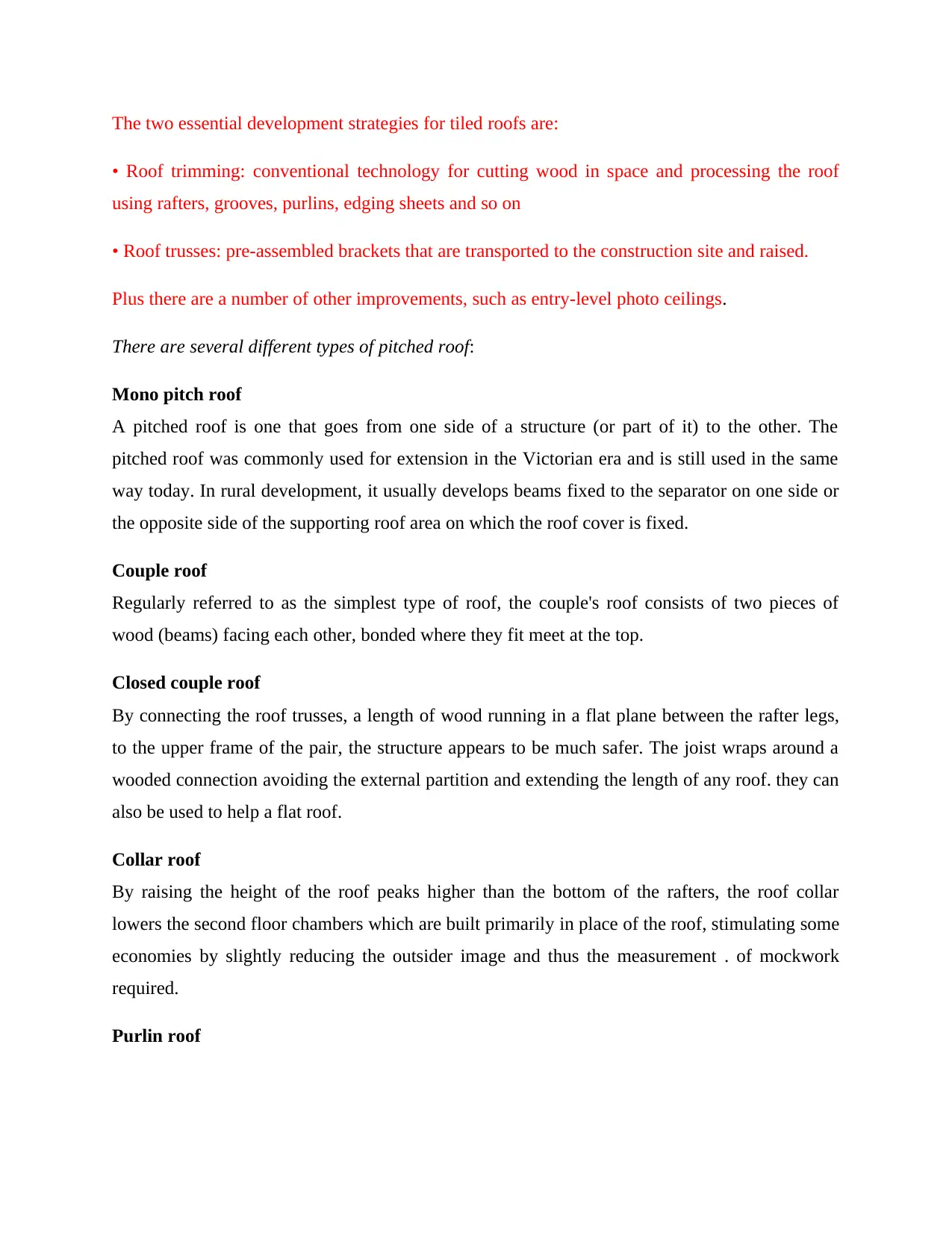
The two essential development strategies for tiled roofs are:
• Roof trimming: conventional technology for cutting wood in space and processing the roof
using rafters, grooves, purlins, edging sheets and so on
• Roof trusses: pre-assembled brackets that are transported to the construction site and raised.
Plus there are a number of other improvements, such as entry-level photo ceilings.
There are several different types of pitched roof:
Mono pitch roof
A pitched roof is one that goes from one side of a structure (or part of it) to the other. The
pitched roof was commonly used for extension in the Victorian era and is still used in the same
way today. In rural development, it usually develops beams fixed to the separator on one side or
the opposite side of the supporting roof area on which the roof cover is fixed.
Couple roof
Regularly referred to as the simplest type of roof, the couple's roof consists of two pieces of
wood (beams) facing each other, bonded where they fit meet at the top.
Closed couple roof
By connecting the roof trusses, a length of wood running in a flat plane between the rafter legs,
to the upper frame of the pair, the structure appears to be much safer. The joist wraps around a
wooded connection avoiding the external partition and extending the length of any roof. they can
also be used to help a flat roof.
Collar roof
By raising the height of the roof peaks higher than the bottom of the rafters, the roof collar
lowers the second floor chambers which are built primarily in place of the roof, stimulating some
economies by slightly reducing the outsider image and thus the measurement . of mockwork
required.
Purlin roof
• Roof trimming: conventional technology for cutting wood in space and processing the roof
using rafters, grooves, purlins, edging sheets and so on
• Roof trusses: pre-assembled brackets that are transported to the construction site and raised.
Plus there are a number of other improvements, such as entry-level photo ceilings.
There are several different types of pitched roof:
Mono pitch roof
A pitched roof is one that goes from one side of a structure (or part of it) to the other. The
pitched roof was commonly used for extension in the Victorian era and is still used in the same
way today. In rural development, it usually develops beams fixed to the separator on one side or
the opposite side of the supporting roof area on which the roof cover is fixed.
Couple roof
Regularly referred to as the simplest type of roof, the couple's roof consists of two pieces of
wood (beams) facing each other, bonded where they fit meet at the top.
Closed couple roof
By connecting the roof trusses, a length of wood running in a flat plane between the rafter legs,
to the upper frame of the pair, the structure appears to be much safer. The joist wraps around a
wooded connection avoiding the external partition and extending the length of any roof. they can
also be used to help a flat roof.
Collar roof
By raising the height of the roof peaks higher than the bottom of the rafters, the roof collar
lowers the second floor chambers which are built primarily in place of the roof, stimulating some
economies by slightly reducing the outsider image and thus the measurement . of mockwork
required.
Purlin roof
⊘ This is a preview!⊘
Do you want full access?
Subscribe today to unlock all pages.

Trusted by 1+ million students worldwide
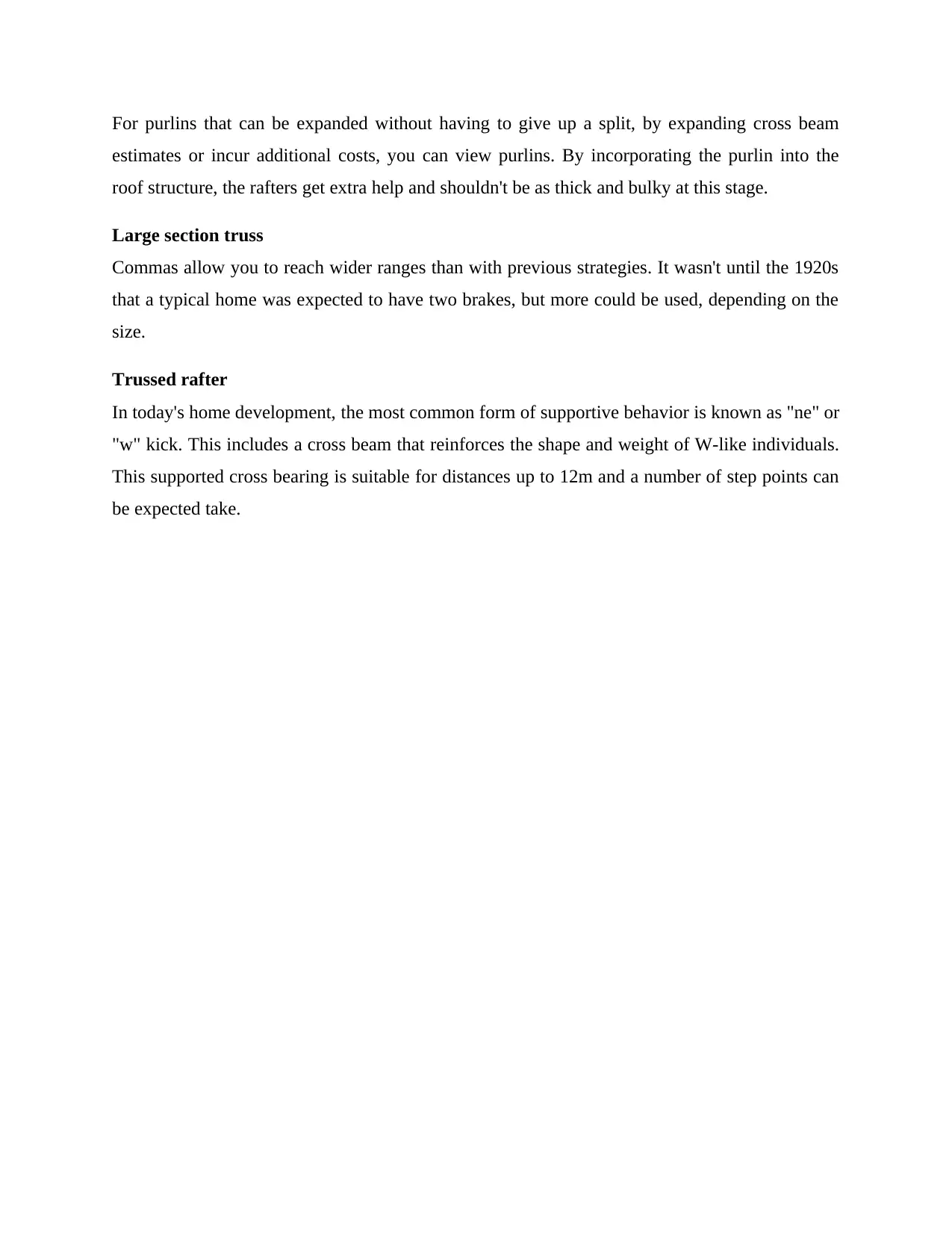
For purlins that can be expanded without having to give up a split, by expanding cross beam
estimates or incur additional costs, you can view purlins. By incorporating the purlin into the
roof structure, the rafters get extra help and shouldn't be as thick and bulky at this stage.
Large section truss
Commas allow you to reach wider ranges than with previous strategies. It wasn't until the 1920s
that a typical home was expected to have two brakes, but more could be used, depending on the
size.
Trussed rafter
In today's home development, the most common form of supportive behavior is known as "ne" or
"w" kick. This includes a cross beam that reinforces the shape and weight of W-like individuals.
This supported cross bearing is suitable for distances up to 12m and a number of step points can
be expected take.
estimates or incur additional costs, you can view purlins. By incorporating the purlin into the
roof structure, the rafters get extra help and shouldn't be as thick and bulky at this stage.
Large section truss
Commas allow you to reach wider ranges than with previous strategies. It wasn't until the 1920s
that a typical home was expected to have two brakes, but more could be used, depending on the
size.
Trussed rafter
In today's home development, the most common form of supportive behavior is known as "ne" or
"w" kick. This includes a cross beam that reinforces the shape and weight of W-like individuals.
This supported cross bearing is suitable for distances up to 12m and a number of step points can
be expected take.
1 out of 10
Related Documents
Your All-in-One AI-Powered Toolkit for Academic Success.
+13062052269
info@desklib.com
Available 24*7 on WhatsApp / Email
![[object Object]](/_next/static/media/star-bottom.7253800d.svg)
Unlock your academic potential
Copyright © 2020–2025 A2Z Services. All Rights Reserved. Developed and managed by ZUCOL.



